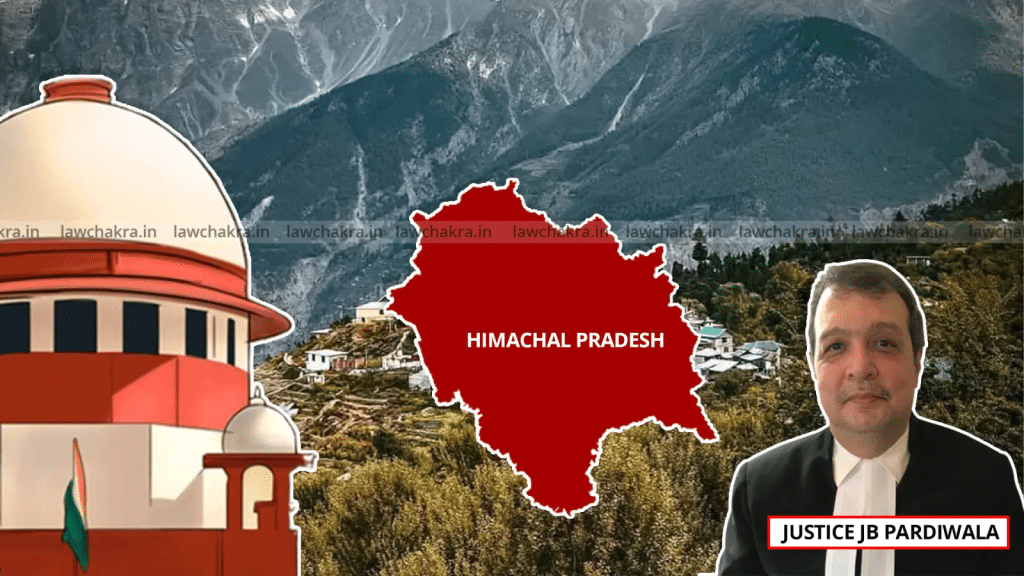
When glaciers retreat, rivers flood, and forests burn – a Himalayan paradise stands on the edge of erasure.
On 2nd August 2025, the Supreme Court of India sounded one of its harshest environmental alarms. The bench led by Justice J.B. Pardiwala declared that if reckless construction and climate inaction continue, “Himachal Pradesh may vanish in thin air.”
This was not poetic exaggeration but a judicial recognition that a fragile mountain ecosystem is collapsing. The Court emphasized: “Revenue cannot be earned at the cost of the environment and ecology.”
Melting Glaciers, Collapsing Slopes, and Vanishing Forests: Why Himachal’s Fragile Landscape Is Breaking Apart
Himachal Pradesh, or “Dev Bhoomi” – land of the gods – is now at the forefront of India’s climate crisis.
Glaciers Melt: The Bara Shigri Glacier, the largest in the Himalayas, has retreated 2–2.5 km. Two-thirds of its 2,500+ glaciers are melting in the state overall.
Cloudbursts and Floods: In 2023, there were 117 cloudbursts in Himachal that swept away bridges, houses, and fields. The loss was put at ₹8,000 crore.
Irregular Rainfall: In 2023, the monsoon dumped 22% more rain than predicted, causing fatal landslides that cut off districts for weeks.
Forest Fires: In 2023, more than 1,900 fires torched 25,000 hectares of forest cover, threatening biodiversity such as the Western Tragopan (state bird).
Landslides on the Rise: With 117 large landslides in 2022–23, Himachal has become India’s most disaster-ravaged state.
The very landscape that once defined Himachal is breaking apart.
A History of Warnings Ignored: From Kinnaur to Manali
This crisis didn’t erupt overnight. Himachal has witnessed repeated disasters:
- 2013 Kinnaur landslides killed 10+ and displaced thousands.
- In 2021 Kinnaur rockfall crushed a bus, killing 9 tourists – a chilling reminder that “safe zones” no longer exist.
- The 2023 Manali floods devastated infrastructure and livelihoods, leaving losses worth ₹12,000 crore.
Environmentalists had warned for decades. From the Chipko movement in the 1970s to modern reports by the Centre for Science and Environment (CSE), experts repeatedly cautioned against overexploitation of the Himalayas. Policymakers largely looked away.
Unplanned Construction and Human Greed: How Development Without Limits Is Turning the Himalayas Into a Danger Zone
Tourism and infrastructure have brought revenue, but at a devastating cost.
- Fragile slopes are blasted to expand four-lane highways.
- Hotels and resorts mushroom on sacred hillsides.
- Hydropower tunnels destabilize villages – as seen in Kinnaur, where locals reported cracks in homes after dam tunneling.
A Shimla shopkeeper put it bluntly: “Tourists bring money, but they also bring our destruction. The mountains are crumbling beneath our feet.”
Supreme Court’s Intervention: No More Concrete on Sacred Hills, No More Profits at Nature’s Expense
In response, the Supreme Court has taken strong steps:
- Blocked new construction in eco-sensitive “green areas” like Shri Tara Mata Hill.
- Dismissed hotel appeals seeking clearance in fragile zones.
- Ordered the state to submit a comprehensive 4-week environmental action plan.
- Kept the case alive under suo motu monitoring, ensuring continuous oversight.
This judgment may shape not just Himachal’s future but the broader approach to Himalayan development.
Himachal’s Collapse Will Not Stay in Himachal: Why India’s Future Is Tied to Its Mountains
The Himalayas are not local landscapes – they are lifelines. If Himachal falters, millions across India will suffer.
- Rivers Dry or Flood: The Beas, Sutlej, Ravi, and Chenab sustain Punjab, Haryana, Delhi, and Rajasthan. Their survival depends on Himalayan glaciers.
- Energy Crisis: Himachal generates over 13,000 MW of hydropower. Floods or slope failures could cripple national power grids.
- Apple Economy Shrinking: Worth ₹5,000 crore annually, apple orchards are moving uphill as warming alters harvest zones. Farmers in Shimla and Kinnaur already report losses.
- Tourism in Jeopardy: In 2022, Himachal hosted 1.5 crore visitors – more than double its population. If disasters rise, this lifeline collapses.
The message is clear: Himachal’s survival is India’s survival.
Lessons From Neighbours: What Uttarakhand, Nepal, and Bhutan Teach Us
Himachal’s crisis is not isolated – the entire Himalayan belt is crumbling.
- Uttarakhand’s Kedarnath disaster (2013) killed over 5,000 people in floods and landslides.
- Joshimath sinking (2023) displaced hundreds as land subsidence cracked homes.
- Nepal’s glacial lakes are swelling dangerously, risking outburst floods.
- Bhutan’s eco-tourism model shows a way forward – limiting tourists, preserving forests, and prioritizing sustainability over unchecked profit.
India cannot ignore these warnings.
Global Climate Parallels: From the Alps to the Andes
The Himalayas are not alone.
- In the Swiss Alps, glaciers have shrunk by 60% since 1850.
- In the Andes, Peru has lost 30% of its glaciers in just 50 years.
The IPCC warns: if global warming exceeds 2°C, the Himalayas could lose two-thirds of their ice by 2050. For Himachal, that means rivers drying, crops collapsing, and mass migration.
The Road Ahead: Building a Future Without Burying a Paradise
The Supreme Court’s words must translate into action. Himachal needs urgent steps:
- Replace mass concrete tourism with eco-tourism, homestays, and controlled visitor numbers.
- Launch large-scale reforestation and strengthen forest fire management.
- Reevaluate hydropower in landslide-prone valleys.
- Empower local communities with sustainable livelihoods.
- Mobilize schools, youth, and citizens into climate action movements.
Other Himalayan states, and India as a whole, must follow this blueprint.
Himachal’s Fate Is India’s Test – Will We Save a State or Watch It Disappear in Thin Air?
The words of 2nd August 2025 are not courtroom hyperbole – they are a climate emergency alert.
Himachal is more than a tourist paradise. It is North India’s water tower, a shield against climate chaos, and a cultural heritage zone. If it collapses, it will take with it rivers, farms, jobs, and identities.
The Himalayas have stood for millennia. Whether they stand for the next century depends on us. India must now choose: act sustainably or bury a paradise under greed and rubble.
FOR MORE BLOGS -beyondthepunchlines.com

 Add to favorites
Add to favorites






